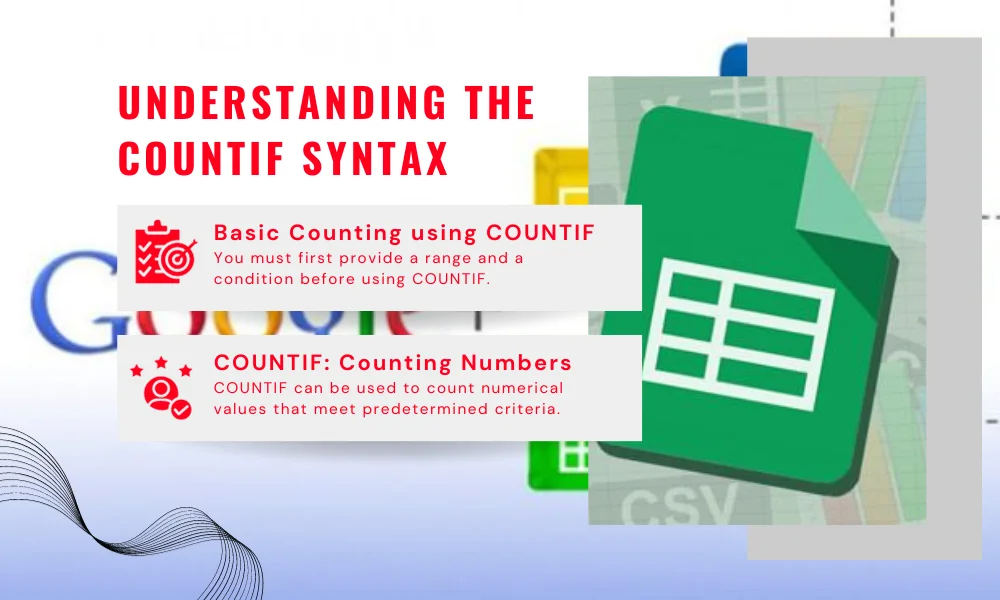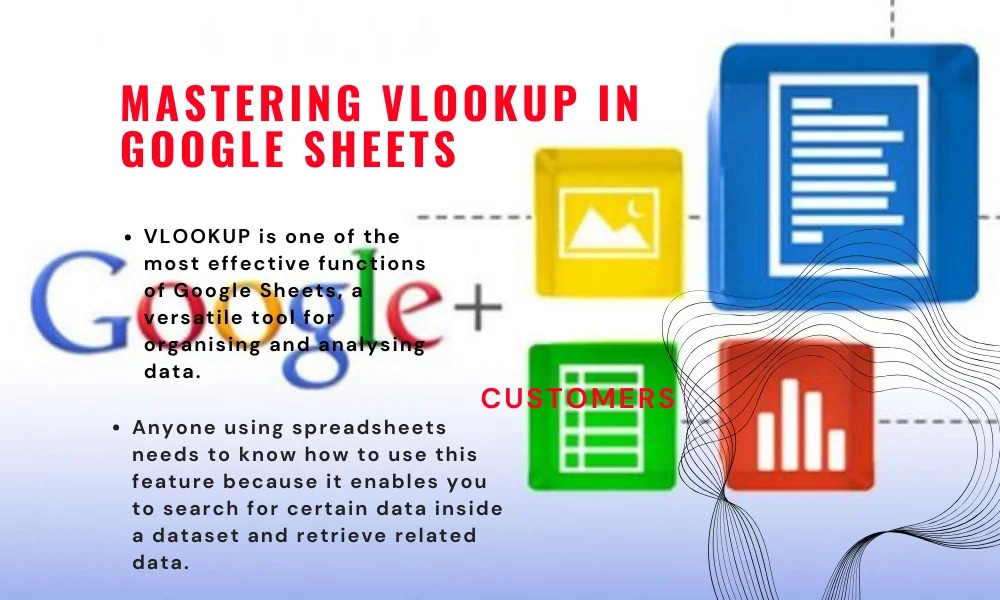Countif Google Sheets
Unlocking the Power of COUNTIF in Google Sheets (Countif Google Sheets)
Understanding spreadsheet functions is crucial in the era of data-driven decision-making. Among the many effective tools available to you in Google Sheets, COUNTIF stands out as a useful feature that can assist you in gathering information, streamlining data analysis, and making decisions.
This in-depth tutorial will cover COUNTIF in Google Sheets, examining its features, uses, and real-world applications. You’re going to unleash the power of COUNTIF and advance your data analysis, whether you’re a novice or a seasoned spreadsheet user. (Countif Google Sheets)
Introduction to COUNTIF (Countif Google Sheets)
The well-liked spreadsheet programme Google Sheets has a tonne of features that make it simple to analyze data. One of these is COUNTIF, a useful tool that lets you count the number of cells that match a certain set of requirements. (Countif Google Sheets)
When it comes to manipulating and analysing data, this function’s apparent simplicity belies its power. (Countif Google Sheets)

Understanding the COUNTIF Syntax (Countif Google Sheets)
2.1. Using COUNTIF for Basic Counting
When using COUNTIF, you must first specify a range and a condition. The number of cells in that range that satisfy the specified condition is then counted. For instance, COUNTIF can be useful if you want to count the number of sales that total more than $1,000 in a particular dataset.
2.2. Combining COUNTIF with Logical Operators (Countif Google Sheets)
Use logical operators like “>” (greater than), “” (less than), “>=” (greater than or equal to), and “=” (less than or equal to) in your criteria to increase the power of COUNTIF. This enables you to adjust your counting based on particular circumstances.
Counting Based on Criteria (Countif Google Sheets)
3.1. Counting Numbers with COUNTIF
You can use COUNTIF to count numerical values that satisfy specific requirements. You could, for instance, tally the number of pupils who achieved a test score of 90 or higher. (Countif Google Sheets)
3.2. Counting Text Values with COUNTIF (Countif Google Sheets)
COUNTIF excels at counting text values in addition to numerical quantities. This function can be used to categories data or keep track of the usage of certain terms.
COUNTIF with Multiple Conditions
…
Real-World Examples (Countif Google Sheets)
14.1. Tracking Project Deadlines
You can use COUNTIF to monitor deadlines in a project management setting. You may, for instance, keep track of how many tasks are past due or have deadlines coming up.
14.2. Analyzing Customer Feedback
Businesses can use COUNTIF to efficiently analyze client feedback. You can learn a lot about client happiness by counting keywords or attitudes in customer evaluations.
Conclusion (Countif Google Sheets)
Finally, COUNTIF is a powerful function in Google Sheets that gives you the ability to handle data precisely and effectively. Whether you work as a business analyst, teacher, or simply interact with data on a regular basis, learning COUNTIF can help you save time and gain insightful information.
Don’t pass up the chance to utilize Google Sheets’ COUNTIF function to its fullest. Try it out now and discover new opportunities for your data analysis journey.
FAQs (Countif Google Sheets)
- Is COUNTIF case-sensitive in Google Sheets?
- No, case does not matter when using COUNTIF in Google Sheets. It does not consider the case of text values.
- Can I use COUNTIF to count cells with specific colors?
- No, COUNTIF is unable to tally cells based on their colour. For this capability, you would need to use Google Apps Script or add-ons.
- What is the maximum number of criteria you can use with COUNTIF?
- Google Sheets’ COUNTIF function allows you to utilize up to 30 criteria.
- Is COUNTIF available in other spreadsheet software?
- Indeed, the COUNTIF function is a widely used one that can be found in many spreadsheet programme, including Microsoft Excel and LibreOffice Calc.
- Can I use COUNTIF to count cells with dates before a specific date?
- Absolutely! COUNTIF can be used to count cells that include dates based on certain criteria, such as dates that are before a particular date.
It’s time to put your newly acquired understanding of Google Sheets’ COUNTIF command into use. Explore your data, try out various criteria, and observe how COUNTIF enables you to quickly and easily derive insightful conclusions.

Mastering VLOOKUP in Google Sheets
One of the most potent features of Google Sheets, a flexible tool for managing and analyzing data, is VLOOKUP. This function is essential for anyone working with spreadsheets since it allows you to search for certain data inside a dataset and obtain related data.
In this manual, we’ll go in-depth on Google Sheets’ VLOOKUP function, covering its syntax, uses, and useful examples. You will soon be able to use VLOOKUP to expedite your data activities and make educated judgements, regardless of whether you are a novice or expert user.
Introduction to VLOOKUP
A function in Google Sheets called VLOOKUP, which stands for “Vertical Lookup,” enables you to look for a value in the first column of a range (or table) and obtain data in the same row from a certain column. It is frequently used for activities like looking up product information, putting personnel IDs and names together, or summarizing financial data.
In summary, Google Sheets’ VLOOKUP feature is a game-changer for managing and analyzing data. It enables users to work with enormous datasets and make informed decisions because of its capability to search and retrieve information quickly.
You can manipulate data in novel ways and cut down on errors if you can understand VLOOKUP. VLOOKUP is a skill worth learning whether you work as a business analyst, are a student, or simply deal with data on a regular basis.
Understanding the VLOOKUP Syntax
2.1. The Lookup Value
The data point in your dataset that you want to search for is the lookup value. Typically, you enter a value directly into the formula or a cell reference.
.
2.2. The Table Array
The range of cells in the table array are those where you want to lookup a value. Both the columns from which you want to get data and the column holding the lookup value should be included.
2.3. The Column Index Number
The column from which you want to obtain data is represented by this number. It refers to the table array in a relative manner. The column index number is 3, for instance, if the information you require is in the third column of the table array.
2.4. Range Lookup
When looking for the lookup value, this component of the grammar indicates whether you want an exact match (FALSE) or an approximation (TRUE). An approximate match enables finding the nearest value whereas an exact match necessitates that the lookup value be identical to a value in the first column.
Exact Match vs. Approximate Match
Practical Applications
7.1. Inventory Management
VLOOKUP is essential for discovering product details fast in inventory management. For instance, by looking up a product’s unique identifier, you can use VLOOKUP to receive information about its price, description, or source.
7.2. Financial Analysis
VLOOKUP is often used by finance experts to analyze financial data. By matching stock symbols, it allows customers to access data such as stock prices, dividend yields, or earnings per share.
7.3. Employee Databases
VLOOKUP is frequently used by HR departments to maintain personnel datasets. HR chores can be made easier by searching for an employee’s ID and retrieving their name, department, or hire date. (Countif Google Sheets)
Conclusion
In summary, Google Sheets’ VLOOKUP feature is a game-changer for managing and analyzing data. It enables users to work with enormous datasets and make informed decisions because of its capability to search and retrieve information quickly.
You can manipulate data in novel ways and cut down on errors if you can understand VLOOKUP. VLOOKUP is a skill worth learning whether you work as a business analyst, are a student, or simply deal with data on a regular basis.
google sheets formulas
Google Sheets is a flexible spreadsheet programme that can be used for everything from basic data entry to sophisticated data analysis.
The fundamental building block of its functionality is the ability to comprehend and use mathematics. We will examine important Google Sheets formulas, their syntax, and real-world uses in this comprehensive book.
Whether you’re a novice or a seasoned user, this tutorial will assist you in maximising Google Sheets’ capabilities.
In Google Sheets, formulas are expressions that carry out calculations or deal with data. The function or expression you want to evaluate is placed before the equals symbol (=).
Formulas can be used for anything from basic math operations to intricate data analysis procedures.
Basic Arithmetic Formulas
2.1. Addition (+)
You can combine up to two numbers with the addition operator (+). For instance, the formula =A1 + B1 will sum the contents of cells A1 and B1.
2.2. Subtraction (-)
One number is subtracted from another using the subtraction operator (-). For example, the formula =A1 – B1 will deduct the value from cell A1 and add the value from cell B1.
2.3. Multiplication (*)
You can multiple numbers by using the (*) multiplication operator. The values in cells A1 and B1 will be multiplied, for instance, by =A1 * B1.
2.4. Division (/)
For division operations, use the division operator (/). By using the formula =A1 / B1, for instance, the value in cell A1 will be divided by the value in cell B1.
Common Functions
3.1. SUM()
…
Efficiency Tips and Tricks
11.1. Named Ranges
To make it simpler to refer to a cell or range of cells in formulas, named ranges let you give them a name. This can make your formulas much easier to read and help you catch mistakes.
11.2. AutoFill
By swiftly filling in a succession of values or formulas based on a pattern, AutoFill is a time-saving tool. To extend the pattern, merely drag the fill handle (a little square in a cell’s bottom-right corner).
11.3. Cell Referencing
…
Common Formula Errors and Troubleshooting
…
Formula Auditing and Evaluation
…
Real-Life Examples
14.1. Sales Forecasting
You may use Google Sheets algorithms to make business predictions about future sales based on historical data. For this, tools like AVERAGE(), TREND(), and FORECAST() are useful. (Countif Google Sheets)
14.2. Gradebook Management
By building gradebooks with formulas, Google Sheets can help educators and students. Calculating grades, keeping track of attendance, and providing insights into academic achievement are all made easier by functions like AVERAGE(), IF(), and VLOOKUP().
Conclusion
To sum up, Google Sheets formulas are strong tools that give you the ability to carry out a variety of calculations and data manipulations. Understanding these formulas is crucial for managing funds, analyzing data, and organising information.
Understanding the syntax and uses of different Google Sheets formulae will help you manage work more effectively, save time, and make wise decisions.
Try out various calculations, look into complex functions, and learn how Google Sheets can make your work easier. (Countif Google Sheets)

